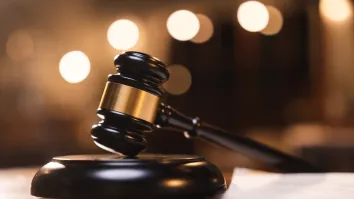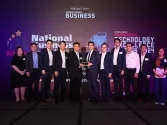Fault study at Oi nuke plant may impact all offline reactors
Toyo University professor Mitsuhisa Watanabe, a polemicist on active faults, has fought a long losing battle
against Japan's nuclear industrial complex.
His research, ringing the alarm bell about active faults under and near nuclear power plants, has always fallen
on deaf ears.
According to Watanabe, nuclear regulators and power companies have a long history of willfully underestimating
the danger posed by active faults near a number of reactors.
But now the Fukushima nuclear crisis may have finally changed the rules of the game.
Watanabe, thanks to recommendations from academic societies, now sits on the five-member expert panel
investigating possible active faults beneath the Oi nuclear plant in Fukui Prefecture.
Watanabe is leading the discussions at the panel, which may determine the Oi plant's fate. He has maintained
that a potentially dangerous active fault runs directly beneath critical equipment for units 3 and 4, the only
two commercial reactors in Japan currently operating. He has called for their immediate shutdown until thorough
geological surveys can be conducted.
"Active faults run parallel in many cases. If you determine one fault is active, the possibility becomes higher
that nearby parallel faults may also be active," Watanabe told The Japan Times during a recent interview. "You
need to stop the reactors to conduct thorough surveys to check all of them first."
All of the other members of the expert panel have admitted that the fault, named F-6, could be active and pose
a serious danger.
Watanabe believes this is good enough reason for the government to order a temporary shutdown and conduct
exhaustive geological surveys.
"If you can't deny the possibility that it may be an active fault, we should not ignore the risk. The plant
should first be suspended."
Watanabe also pointed out that seismic experts in the pay of the nuclear power industry have drawn severe
criticism for playing down the risk of massive quakes and tsunami before the catastrophic breakdowns at the
Fukushima No. 1 power plant.
"We should not repeat the same mistake that was made in Fukushima," he said.
The expert panel's judgment on the Oi plant is likely to have a significant impact on the fate of many other
nuclear plants and probably the future of national energy policy as well.
The Fukushima meltdown crisis prompted regulators and utilities to assess possible quake risks at nuclear
plants across the country, including those from potentially active faults.
The Nuclear Regulation Authority is set to draw up new safety standards that will set conditions for power
utilities to reactivate any of the reactors halted in light of the Fukushima crisis.
Proving there is no active faults nearby is likely to be one of the key conditions before the NRA approves
reactivation of any nuclear plant.
"What I'm most concerned about are issues involving faults," Shunichi Tanaka, chairman of the NRA, recently
told Kyodo.
The NRA will request Kansai Electric Power Co. to stop the reactors at Oi if the F-6 fault is determined to be,
or is strongly suspected of being, active, Tanaka said.
The brand-new agency has launched geological investigations into six nuclear plants where suspicion is high
that they may have active faults within their fences.
The Oi plant is the first to be examined by the experts. The other five are Fukui's Tsuruga and Mihama power
plants, the Shiga plant in Ishikawa Prefecture, the Higashidori plant in Amori Prefecture and the Monju
experimental fast-breeder reactor, also in Fukui.
Following a survey Nov. 2 at the Oi plant, which included digging trenches, the NRA plans to conduct a similar
study at the Tsuruga plant Dec. 1 and at the Higashidori facility before the end of the year.
The Oi case has also drawn particular attention because its reactors 3 and 4 are the only ones the government
has managed to reactivate in the face of the public's rising opposition to nuclear energy.
For now the NRA expert panel's focus is on whether the F-6 fault is active.
Some of the panel members suspect F-6 may have been created by a landslide, not an earthquake, and thus would
be considered generally less dangerous. Kepco insists this is the case, but Watanabe isn't buying it. He says
the fault appears to have moved up against a slope, making it unlikely a landslide was involved in its
creation.
"Media tend to focus on debates about whether it was created by an earthquake or landslide. But that's not the
most important point," he said.
Watanabe argues that utilities always try to play down any risk posed by active faults out of fear their
reactors could be shut down.
"The nuclear regulator and power companies have long tried to underestimate (the danger) of active faults,
worrying it would affect power supply capacity," Watanabe said, using the Shimane nuclear plant in Matsue,
Shimane Prefecture, as an example.
Takashi Nakata, now a professor emeritus at Hiroshima University, had long pointed out there is a fault near
the Shimane plant that was overlooked by Chugoku Electric Power Co. before it built the facility.
Initially the utility denied the existence of the active fault. Then when it admitted in 1998 the fault was
there, it estimated the length at only 8 km.
Facing further criticism from Nakata, Watanabe and other experts, Chugoku Electric extended the estimated
length of the Shinji Fault to 10 km in 2004 when it applied for approval to build a third reactor at the plant.
The company eventually was forced to revise its estimate to 22 km in 2008, but only after outside experts dug
up the ground to show the fault actually extend that far.
The longer a fault is, the more powerful the earthquake it can cause, which is possibly why Chugoku Electric
was reluctant to admit the Shinji Fault stretches as far as it does, Watanabe said.
The nearest point of the active fault is currently considered to be about 2.8 km south of the plant. The
utility argues the reactors can withstand an earthquake that could be generated by a fault that size.
The NRA's expert panel plans to conduct another survey in which a trench will be dug within the plant's
compound by the end of the year.
However, Watanabe said a one-time survey like that will be far from sufficient to examine all of the suspected
faults within the compound.
He stressed the importance of making sure the panels that will be investigating the faults under and near power
plants are totally independent of vested interests in the nuclear industry.
To ensure independence, the panels should be given a budget and the authority to conduct on-site surveys
wherever they believe it's necessary, he said.
https://www.japantimes.co.jp/text/nn20121116f1.html








![Cross Domain [Manu + SBR + ABF + ABR + FMCG + HBR + ]](https://cmg-qa.s3.ap-southeast-1.amazonaws.com/s3fs-public/styles/exclusive_featured_article/public/2025-01/earth-3537401_1920_4.jpg.webp?itok=WaRpTJwE)
![Cross Domain [SBR + ABR]](https://cmg-qa.s3.ap-southeast-1.amazonaws.com/s3fs-public/styles/exclusive_featured_article/public/2025-01/pexels-jahoo-867092-2_1.jpg.webp?itok=o7MUL1oO)









 Advertise
Advertise


